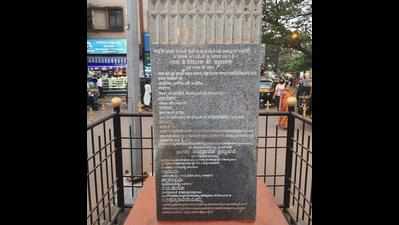- News
- City News
- hubballi News
- Gandhi inspired non-Brahmins to take the plunge in freedom struggle in Dharwad
Trending
This story is from November 10, 2020
Gandhi inspired non-Brahmins to take the plunge in freedom struggle in Dharwad
As the district gears up for the centenary celebrations of Mahatma Gandhi’s visit to Dharwad – he visited the district then in Bombay Presidency on November 10, 1920 – the spotlight has turned to his efforts to rope in non-Brahmins and women into the Congress, and by extension, the freedom struggle. History attests to the success the Mahatma had in this endeavour, as indicated by the spurt in the representation of women and non-Brahmin leaders across the Dharwad region.

The memorial in Dharwad commemorating Mahatma Gandhi’s visit to the city on November 10, 2020
HUBBALLI: As the district gears up for the centenary celebrations of Mahatma Gandhi’s visit to Dharwad – he visited the district then in Bombay Presidency on November 10, 1920 – the spotlight has turned to his efforts to rope in non-Brahmins and women into the Congress, and by extension, the freedom struggle. History attests to the success the Mahatma had in this endeavour, as indicated by the spurt in the representation of women and non-Brahmin leaders across the Dharwad region.
Honorary secretary of Gandhi Peace Foundation in Dharwad Basavaprabhu Hosakeri recalled that around the time of Gandhi’s momentous visit to Dharwad, Narayanrao B Kabbur, Ranganath R Diwakar, Mudaveedu Krishnaraya, Tirumalarao Joshi – all of whom belonged to the upper castes – were well-established leaders of the freedom struggle in the region.
“In the wake of ‘Lokmanya’ Bal Gangadhar Tilak’s death in August 1920, it was the Mahatma who had to shoulder the responsibility of ensuring that the freedom movement represented all sections of society. He motivated non-Brahmins such as Sir Siddappa Kambali, Gudleppa Hallikeri, Mailara Mahadeva, Hosamani Siddappa, Anadanappa Doddameti and women such as Umabai Kundapur, Krishnabai Panajikar, Kusumatai Deshpande to join the movement. It was Gandhi who inspired hundreds of youngsters among Muslims, Lingayats and other backward communities to join the Congress. The result of the increased participation from across the spectrum of society was that more demonstrations were held, one of which was the picketing of a liquor outlet at Jakani Bhavi Circle in July ’21 wherein three Muslims – Maliksab alias Mardansab, Gousab alias Khadersab and Abdul Gafar Chokathai – who were volunteers for the Khilafat Movement were martyred in police firing,” said Hosakeri.
Recalling an interesting anecdote involving the Mahatma and Siddappa Kambali, Hosakeri said, “When Gandhi visited Hubballi on November 11, 1920, Kambali expressed his resentment about the Congress being dominated mostly by the upper caste members. Replying to this, Gandhi said that, should Kambali join the Congress, this inequality would be addressed. Gandhi was also worried whether or not Siddharrodh Swamiji, a sanyasi, would agree to preside over the meeting on Koppikar Road. But the seer assured the Mahatma, that while he may be a sanyasi, he was nevertheless a patriot.”
Honorary secretary of Gandhi Peace Foundation in Dharwad Basavaprabhu Hosakeri recalled that around the time of Gandhi’s momentous visit to Dharwad, Narayanrao B Kabbur, Ranganath R Diwakar, Mudaveedu Krishnaraya, Tirumalarao Joshi – all of whom belonged to the upper castes – were well-established leaders of the freedom struggle in the region.
“In the wake of ‘Lokmanya’ Bal Gangadhar Tilak’s death in August 1920, it was the Mahatma who had to shoulder the responsibility of ensuring that the freedom movement represented all sections of society. He motivated non-Brahmins such as Sir Siddappa Kambali, Gudleppa Hallikeri, Mailara Mahadeva, Hosamani Siddappa, Anadanappa Doddameti and women such as Umabai Kundapur, Krishnabai Panajikar, Kusumatai Deshpande to join the movement. It was Gandhi who inspired hundreds of youngsters among Muslims, Lingayats and other backward communities to join the Congress. The result of the increased participation from across the spectrum of society was that more demonstrations were held, one of which was the picketing of a liquor outlet at Jakani Bhavi Circle in July ’21 wherein three Muslims – Maliksab alias Mardansab, Gousab alias Khadersab and Abdul Gafar Chokathai – who were volunteers for the Khilafat Movement were martyred in police firing,” said Hosakeri.
Recalling an interesting anecdote involving the Mahatma and Siddappa Kambali, Hosakeri said, “When Gandhi visited Hubballi on November 11, 1920, Kambali expressed his resentment about the Congress being dominated mostly by the upper caste members. Replying to this, Gandhi said that, should Kambali join the Congress, this inequality would be addressed. Gandhi was also worried whether or not Siddharrodh Swamiji, a sanyasi, would agree to preside over the meeting on Koppikar Road. But the seer assured the Mahatma, that while he may be a sanyasi, he was nevertheless a patriot.”
Referencing NH Katgeri’s ‘Gata Kaalada Dharwad (Dharwad of yore)’, social worker Uday Yandigeri said that the the Muslims and Brahmins were the targets of the English’s ‘Divide and Rule’ policy. “The then collector of Dharwad district arrested 29 people for picketing at the Jakani Bhavi Circle, of whom 15 were Brahmins, 13 were Muslims and one was a Maratha. He wanted Lingayats as witnesses so he could file false cases. But members of the Linhayat community, inspired to join the struggle after Gandhi’s visit, only helped intensify the movement for freedom,” Yandigeri said.
End of Article
FOLLOW US ON SOCIAL MEDIA










